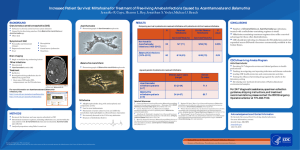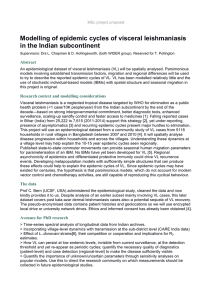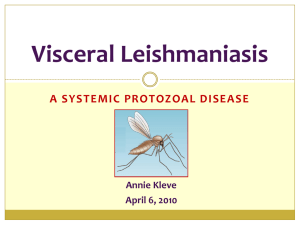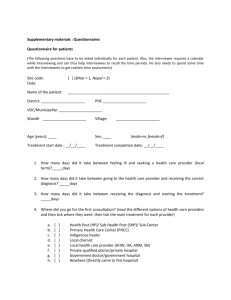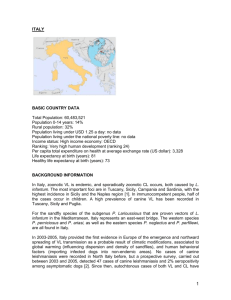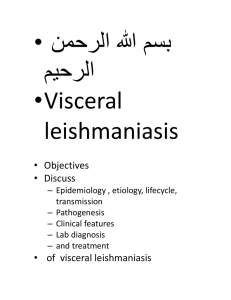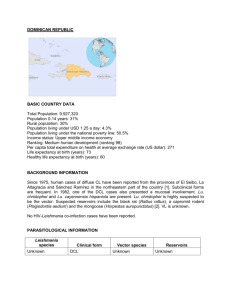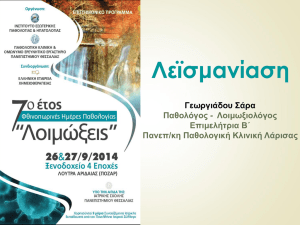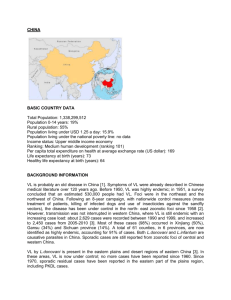Document 13847912
advertisement
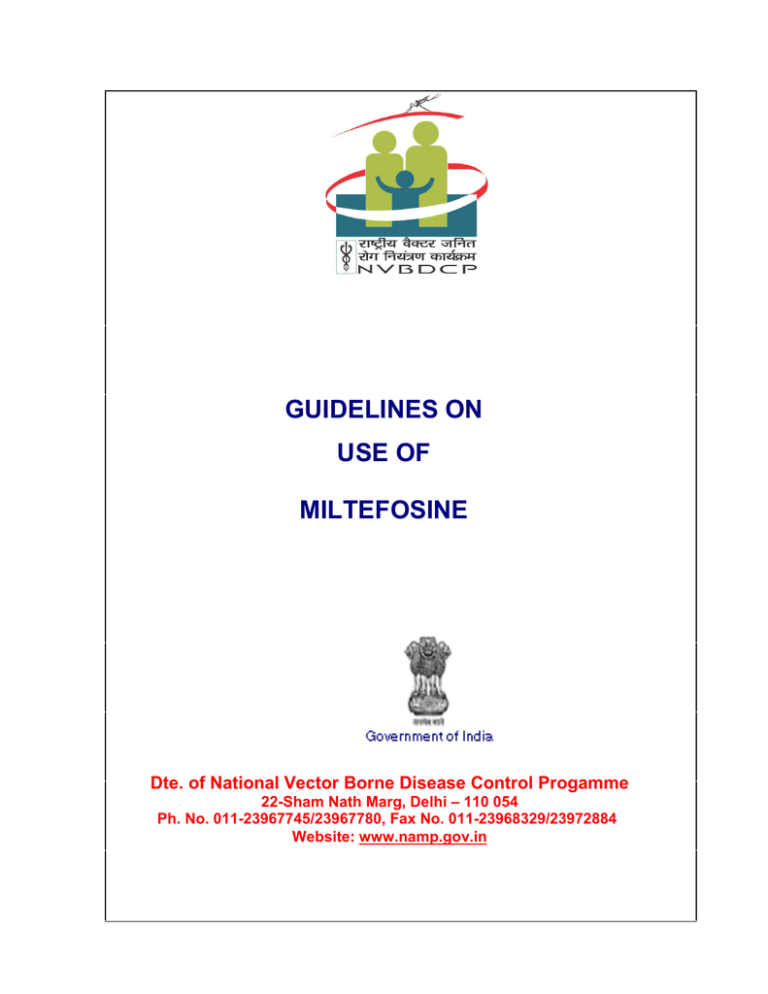
GUIDELINES ON USE OF MILTEFOSINE Dte. of National Vector Borne Disease Control Progamme 22-Sham Nath Marg, Delhi – 110 054 Ph. No. 011-23967745/23967780, Fax No. 011-23968329/23972884 Website: www.namp.gov.in GUIDELINES ON USE OF ORAL DRUG MILTEFOSINE FOR THE TREATMENT OF KALA-AZAR IN THE ENDEMIC STATES ON A PILOT BASIS. GUIDELINES ON USE OF MILTEFOSINE Preamble: Visceral Leishmaniasis (VL) is an important public health problem, in India, besides, Nepal, Bangladesh, Sudan, and Brazil. Thousands of cases of kala-azar are reported every year, globally. If untreated, kala-azar is almost always fatal, as a result of intercurrent infection. The standard drug for the treatment of VL is a pentavalent antimonial, sodium antimony gluconate (SAG) administered parenterally. The second-line drug, amphotericin B desoxycholate, is also parenteral and is more toxic as compared to SAG. Liposomal amphotericin B is effective and safe, but it is very expensive even for developed countries and prohibitively so for regions of endemicity. Miltefosine (hexadecylphosphocholine) is an oral drug that was originally studied as an antitumor agent. Subsequent to the serendipitous laboratory finding that miltefosine was active against Leishmania in vitro and, after oral administration in laboratory animals, the drug was developed in a public-private partnership for the treatment of visceral leishmaniasis or kala-azar. In a phase three trial involving Indian adults,, miltefosine given at a dosage of 2.5 mg/kg per day for 28 days cured 282 (97%) of 291 evaluable patients who remained parasitologically and clinically free even after 6 months of follow-up. The phase-IV trial of miltefosine were undertaken by ICMR for testing the applicability of the drug under routine clinical conditions. The cure rates during this operational trial were found to be high. The drug is registered with the Drug Controller General of India. The toxicity associated with the drug is minor. Considering the experience gained in the use of oral drug miltefosine, the Expert Committee, under the Chairmanship of Director General Health Services, GOI recommended that the drug can be used for kala-azar treatment under the kala-azar elimination programme for which necessary guidelines be prepared by an expert group. The guidelines on the use of miltefosine under kala-azar elimination programme are accordingly set out as follows: 1. Area & Patient selection Area Selection: Expert group recommended that initially Vaishali & Saran districts of Bihar should be selected on pilot basis for introduction of capsule miltefosine as first line drug for treatment of cases of kala-azar. These districts are the oldest foci of kala-azar, where the Kala-azar cases were reported in the early 1970’s and consequently have witnessed the highest drug pressure. About 5000 patients in all can be subjected to miltefosine treatment. The patient selection will be on the basis of rK39 dip-stick diagnosis supplemented with splenic aspiration in 5% of the cases. 1 Subjects for treatment with miltefosine would be patients who conform to case definition of kala-azar except pregnant women or any women of child bearing age who does not give an undertaking of refraining from pregnancy (read contraceptive) during the duration of miltefosine therapy and till 2 months after the end of therapy. Following would be the inclusion, exclusion and withdrawal criteria: (i) Inclusion criteria: A clinical diagnosis of active VL or PKDL with consistent signs and symptoms (e.g., fever, splenomegaly, anemia). b) Confirmed diagnosis with rK39 dip-stick or with splenic/ bone marrow smear examination. c) Male or female of ages 2 to 65 years a) (ii) Exclusion criteria will be as follows; Pregnancy or breast-feeding or refusal to use contraceptives during the treatment period and two months after completion of treatment with miltefosine. Miltefosine should not be administered to women of reproductive age group unless they use contraceptives to prevent pregnancy. This should be ensured by providing counseling to patient and her husband. Best contraceptive recommended by the expert group was IUCD as condoms have high failure rate. As an alternative option use of oral pills should be ensured. b) HIV positive serology c) Infants a) (iii) Withdrawal criteria: (during treatment period i.e. to stop the treatment) a) Pregnancy b) Withdrawl of contraceptive measures 2. Mode of Treatment : The treatment will be provided as a Directly Observed Therapy (DOTS). The patient will be induced to report to the treatment center twice a week for treatment. Experience shows that most patients comply with instructions. The treatment will be provided at all additional PHCs within the districts. 3. Dosages After enrollment oral miltefosine treatment will be administered as per following dosage schedule: i. Adults (>12 years) weighing more than 25kg: 100mg miltefosine daily as one capsule (50 mg) in the morning and one capsule in the evening, after meals for 28 days. ii. Adults (>12 years) weighing (less than 25kg) 50mg, miltefosine daily as one capsule (50 mg) in the morning, after meals for 28 days. 2 iii. iv. Children (2-11 years): miltefosine will be given at 2.5 mg/kg daily after meals for 28 days, i.e., 50mg daily once a day. The drug is not to be used in the case of children below 2 years of age. 4. Clinical Response : The response will be judged on clinical grounds, i.e., absence of fever, splenomegaly and anemia. 5. Quality Assurance : The expert group desired that the specification for procurement of miltefosine conform strictly to the chemical content of the drug, and its shelf life, etc. This is all the more necessary since miltefosine is the sole proprietary drug. 6. Drug Storage: The concerned Medical Officer of the treatment center shall be responsible for ensuring that the drug miltefosine is stored in a cool, secure, limited-access area, protected from extremes of light, temperature and humidity. Patients will be educated about these conditions for storage of the drug supplied to them. 7. Adverse Reaction : Adverse reactions to miltefosine are mostly mild. The treating physician should monitor and watch for any adverse reactions. However, 98% of the patients are not likely to present with any adverse drug reaction. Even of those who report gastrointestinal reactions, 90% will have vomiting only once a month. Should any skin rashes or gastro-intestinal symptoms develop the doctor may consider stoppage of the drug and refer the patient to higher treatment centre. A monitoring of renal and hepatic functions is recommended wherever feasible as about 1% patients may develop nephrotoxicity or hepatotoxicity. 8. Information, Education & Communication (IEC) : In view of the risks of development of the resistance to miltefosine the judicious use of the drug is imperative. The unresponsiveness rate to miltefosine has already risen from 3% to 6%. An injudicious use will certainly render a highly effective and safe drug, ineffective in future. IEC campaign to create awareness about the new tools available under the programme should soberly design the messages, to attract the patient to the treatment centre without creating undue hype which may lead to over-consumption. Measures against pilferage of the drug and its leakage to private sector should be ensured. 9. Role of Family : Kala-azar treatment, even with an easy to administer oral drug, miltefosine, is a protracted affair stretching over twenty eight days, and involving twice daily administration of the (in case of adults more than 12 years ago) drug. The family has a direct stake in the successful completion of the treatment, as it is the family that bears the economic burden and possible economic deprivation resulting from the patients illness. Thus the family must know the course of kala-azar treatment, its durations, precautions, and actions in the case of adverse reactions, if any. It must also know the implications of the complete course of treatment and also the difference between symptomatic cure 3 and complete parasitological cure. This is all the more important, as there is a strong tendency on part of the patient to discontinue treatment the moment there is symptomatic relief and he/she begins to feel better. This tendency to skip treatment is a dangerous tendency both for the individual and the community. IEC messages, which can be communicated to the patient and his attendant in the form of a short brochure, should reinforce the need for a complete course of treatment with the following messages: Kala-azar is a life-threatening disease, which is caused by parasite introduced into the body of the patient from another person, through the bite of an insect. It is this kala-azar causing parasite that is responsible for all the suffering of the individual patient and many others in the community. Unless the body of the patient is freed of these parasites, the patient will not recover complete health. This is possible only after the patient consumes the effective drug, miltefosine, over a minimum period of 28 days. Discontinuation of treatment midway is dangerous for the patient, as well as the community, as the parasites of kala-azar if not removed from the body of the patient will again cause the disease in him/her, and what is even worse, some of them be transferred, through the bite of the insect to other healthy individuals. Having gained this much information, the family members must also be alert about the development of similar symptoms in the contacts of the patients. Thus the simple case definition of kala-azar, should also be incorporated in the brochure, so that the contacts and other family members are advised diagnosis at the treatment centre. The simple knowledge can also be utilized in cautioning the neighbour’s to seek proper diagnosis and treatment in case of onset of kala-azar symptoms. The IEC should also emphasize the use of personal protective measures to protect the individual from re-infection. 10. Monitoring : At district level monitoring of the use of miltefosine would be carried out by Chief Medical Officers & District Programme Officers as per operational details under DOTs treatment schedule. Medical Officer Incharges in respective PHCs will bear overall responsibility for ensuring compliance among the patients. Independent monitoring will be carried out by RMRIMS, Patna on a selected sample basis as per protocol to be developed by them. 11. Evaluation : The extension of the miltefosine therapy will be taken up after evaluation of the results of the pilot use in the two districts. The Dte. NVBDCP can extend the area of miltefosine treatment after observing carefully the results of the pilot use. The present expert group can undertake the 4 evaluation of miltefosine after 1 year of the initiation of use in the selected districts. 12. Post Kala-azar Dermal Leishmaniasis (PKDL) : Since there is a widespread concern that cases of PKDL act as the reservoir of a disease in the community, the Expert Group recommended that the dose and duration of miltefosine treatment in the case of PKDL should be studied and studies completed expeditiously. Till then standard treatment of PKDL should be continued. 5 Reference: 1. S. Sundar, M. Sahu, H. Mehta, A. Gupta, U. Kohli, M. Rai. J.D. Bezman and H.W. Murray (2002). Noninvasive Management of Indian Viseceral Leishmaniasis: Clinical application of Diagnosis by K39 antigen strip testing at a kala-azar referral unit. Clin. Inf. Dis. 35.1. 581 – 586 2. Bern, C., Jha S N., Joshi A B, Thakur GD, Bista MB (2000) Use of recombinant K39 dipstick test and direct agglutination test in a setting endemic for visceral leishmaniasis in Nepal. Am. J. Trop. Med. Hyg. 63: 153 – 7. 3. Berman JD (1997) Human Leishmaniasis : Clinical, diagnostic, and chemotherapeutic developments in the past ten years. Clin. Inf. Dis. 24 : 684 – 703. 4. Shyam Sundar, T.K. Jha, C.P. Thakur, Juergen Engel, Herbert Sinderman, Christina Fischer, Klans Jurge, Anthony Bryceson, and Jonathan Berman. (2002). Oral miltefosine for Indian Visceral Leishmaniasis N.Eng. Jour. Med. 347.22. 1739 – 45. 5. WHO. (1990). Control of Leishmaniasis. Report of a WHO Expert Committee. WHO Technical Report Series No. 793. WHO, Geneva. 1 – 158. 6. Sarman Singh, Veena Kumari, and niti Singh. (2002). Predicting Kalaazar Disease manifestation in Asymptomatics with latent leishmania donovani infection by defection of antibody against recombinant K39 antigen. Clin. Diagn. Lab. Immunol. 9(3). 568-572. 6 MILTEFOSINE TREATMENT CARD Capsule No. Date Patient’s signature in case >12 years MO’s Remarks with Signature *1 2 3 st 1 week 4 5 6 7 8 9 10 2nd week 11** 12 13 14 15 16 3rd week 17 18 19 20 21 22 23 4th week 24 25 26 27 28 Report from treatment Centre Treatment Started on Treatment started on …………………. Completed on Completed on ………………………… Full Course of Treatment Cured/Referred to ……………………. Completed/Incomplete ………………………………………... Patient Cured Remarks ……………………………… Referred for Re-exam. Any other 7
